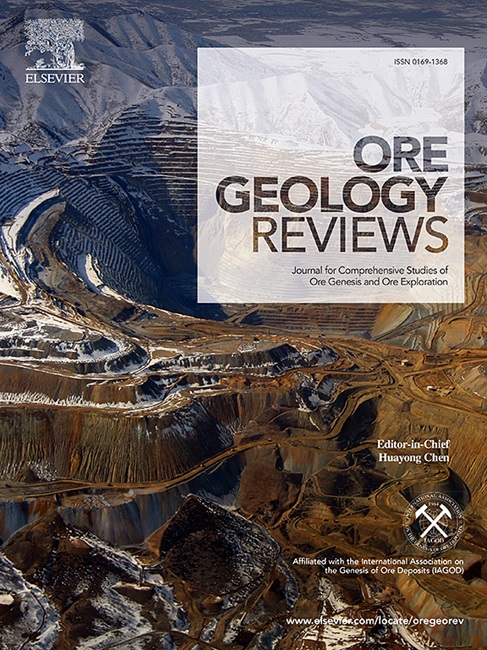侏罗纪-白垩纪增生杂岩中锰铁矿床的成因:对海洋缺氧事件前后深海环境的启示
IF 3.2
2区 地球科学
Q1 GEOLOGY
引用次数: 0
摘要
东京带是日本侏罗—白垩纪增生杂岩,铁、锰矿床沿玄武岩和燧石分布。本文提出了这些铁、锰矿床的成因,并重建了海相Os同位素比值。样品中Ce呈负异常,除Fe和Mn外过渡金属含量低,为典型的海底热液锰铁氧化物。磷灰石富集使铁矿样品中稀土元素富集。若干Mn矿床样品显示正Eu异常,提示高温水岩相互作用。前人研究的红燧石放射虫年龄以及洋中脊和洋岛玄武岩的分布表明,铁矿床是在卡洛世或更早的洋中脊由热液活动形成的。相比之下,Mn矿床是在距离MOR约5 × 103 km的海洋岛屿上,在大约120 Ma时由热液活动形成的。较低的初始Os同位素比值(0.411 ~ 0.445)表明,晚侏罗世海洋缺氧事件(OAE)之前,MOR地区的火山活动较为活跃。西段和南段Mn矿床样品的初始Os同位素比值与OAE1a之前和期间观测到的海相Os同位素比值(分别为~ 124 ~ 119.55 Ma和119.5 ~ 118.5 Ma)相对应。由于锰矿床与红燧石互层,可以推断整个OAE1a的深海中上层区域维持了一个氧化环境。本文章由计算机程序翻译,如有差异,请以英文原文为准。

Origin of ferromanganese deposits in the Jurassic to Cretaceous accretionary complex: Implications for the deep-sea environment around ocean anoxic events
In the Tokoro Belt, which is a Jurassic to Cretaceous accretionary complex in Japan, Fe and Mn deposits are distributed along basaltic rocks and chert. This study proposes the origin of these Fe and Mn deposits and reconstructs marine Os isotope ratios. The samples were found to exhibit negative Ce anomalies and low transition metal contents other than Fe and Mn, which are typical of submarine hydrothermal ferromanganese oxides. The Fe deposit samples were enriched in rare-earth elements due to apatite accumulation. Several Mn deposit samples showed positive Eu anomalies, suggesting high-temperature water–rock interactions. The radiolarian ages of red cherts in previous studies and the distributions of mid-ocean ridge (MOR) and oceanic island basalts indicate that Fe deposits were formed by hydrothermal activity at an MOR in the Callovian or older. In contrast, Mn deposits were formed by hydrothermal activity on oceanic islands approximately 5 × 103 km from the MOR at approximately 120 Ma. The low initial Os isotope ratios of the Fe deposit samples (0.411–0.445) suggest that volcanism in the MOR was active before the Late Jurassic oceanic anoxic event (OAE). The initial Os isotope ratios of the Mn deposit samples from the western and southern sections correspond to the marine Os isotope ratios observed before and during OAE1a (∼124–119.55 Ma and 119.5–118.5 Ma, respectively). As the Mn deposits are interbedded with red chert, it can be inferred that an oxic environment was maintained in the deep-sea pelagic regions throughout OAE1a.
求助全文
通过发布文献求助,成功后即可免费获取论文全文。
去求助
来源期刊

Ore Geology Reviews
地学-地质学
CiteScore
6.50
自引率
27.30%
发文量
546
审稿时长
22.9 weeks
期刊介绍:
Ore Geology Reviews aims to familiarize all earth scientists with recent advances in a number of interconnected disciplines related to the study of, and search for, ore deposits. The reviews range from brief to longer contributions, but the journal preferentially publishes manuscripts that fill the niche between the commonly shorter journal articles and the comprehensive book coverages, and thus has a special appeal to many authors and readers.
 求助内容:
求助内容: 应助结果提醒方式:
应助结果提醒方式:


